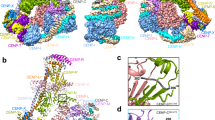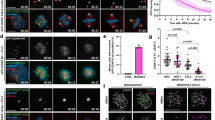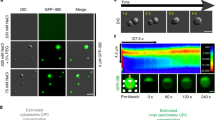Abstract
Mitotic chromosomal assembly in vertebrates is regulated by condensin I and condensin II, which work cooperatively but have different chromosomal localization profiles and make distinct mechanistic contributions to this process. We show here that protein phosphatase 2A (PP2A), which interacts with condensin II but not condensin I, plays an essential role in targeting condensin II to chromosomes. Unexpectedly, our data indicate that PP2A acts as a recruiter protein rather than a catalytic enzyme to target condensin II to chromosomes. This recruiting activity of PP2A was inhibited by okadaic acid, but not by fostriecin, even though both molecules strongly inhibited the catalytic activity of PP2A. Additionally, we found that the chromokinesin KIF4a is also targeted to chromosomes via the noncatalytic activity of PP2A. Thus, our studies reveal a previously unknown contribution of PP2A to chromosome assembly.
This is a preview of subscription content, access via your institution
Access options
Subscribe to this journal
Receive 12 print issues and online access
$189.00 per year
only $15.75 per issue
Buy this article
- Purchase on Springer Link
- Instant access to full article PDF
Prices may be subject to local taxes which are calculated during checkout






Similar content being viewed by others
References
Koshland, D. & Strunnikov, A. Mitotic chromosome condensation. Annu. Rev. Cell Dev. Biol. 12, 305–333 (1996).
Swedlow, J.R. & Hirano, T. The making of the mitotic chromosome: modern insights into classical questions. Mol. Cell 11, 557–569 (2003).
Belmont, A.S. Mitotic chromosome structure and condensation. Curr. Opin. Cell Biol. 18, 632–638 (2006).
Maeshima, K. & Eltsov, M. Packaging the genome: the structure of mitotic chromosomes. J. Biochem. 143, 145–153 (2008).
Gassmann, R., Vagnarelli, P., Hudson, D. & Earnshaw, W.C. Mitotic chromosome formation and the condensin paradox. Exp. Cell Res. 296, 35–42 (2004).
Hirano, T. Condensins: organizing and segregating the genome. Curr. Biol. 15, R265–R275 (2005).
Hagstrom, K.A. & Meyer, B.J. Condensin and cohesin: more than chromosome compactor and glue. Nat. Rev. Genet. 4, 520–534 (2003).
Jessberger, R. The many functions of SMC proteins in chromosome dynamics. Nat. Rev. Mol. Cell Biol. 3, 767–778 (2002).
Hirano, T. & Mitchison, T.J. A heterodimeric coiled-coil protein required for mitotic chromosome condensation in vitro. Cell 79, 449–458 (1994).
Hirano, T., Kobayashi, R. & Hirano, M. Condensins, chromosome condensation protein complexes containing XCAP-C, XCAP-E and a Xenopus homolog of the Drosophila Barren protein. Cell 89, 511–521 (1997).
Kimura, K. & Hirano, T. ATP-dependent positive supercoiling of DNA by 13S condensin: a biochemical implication for chromosome condensation. Cell 90, 625–634 (1997).
Kimura, K., Rybenkov, V.V., Crisona, N.J., Hirano, T. & Cozzarelli, N.R. 13S condensin actively reconfigures DNA by introducing global positive writhe: implications for chromosome condensation. Cell 98, 239–248 (1999).
Kimura, K., Hirano, M., Kobayashi, R. & Hirano, T. Phosphorylation and activation of 13S condensin by Cdc2 in vitro. Science 282, 487–490 (1998).
Takemoto, A., Kimura, K., Yokoyama, S. & Hanaoka, F. Cell cycle–dependent phosphorylation, nuclear localization, and activation of human condensin. J. Biol. Chem. 279, 4551–4559 (2004).
Takemoto, A., Kimura, K., Yanagisawa, J., Yokoyama, S. & Hanaoka, F. Negative regulation of condensin I by CK2-mediated phosphorylation. EMBO J. 25, 5339–5348 (2006).
Ono, T. et al. Differential contributions of condensin I and condensin II to mitotic chromosome architecture in vertebrate cells. Cell 115, 109–121 (2003).
Yeong, F.M. et al. Identification of a subunit of a novel Kleisin-β–SMC complex as a potential substrate of protein phosphatase 2A. Curr. Biol. 13, 2058–2064 (2003).
Hagstrom, K.A., Holmes, V.F., Cozzarelli, N.R. & Meyer, B.J. C. elegans condensin promotes mitotic chromosome architecture, centromere organization, and sister chromatid segregation during mitosis and meiosis. Genes Dev. 16, 729–742 (2002).
Gerlich, D., Hirota, T., Koch, B., Peters, J.M. & Ellenberg, J. Condensin I stabilizes chromosomes mechanically through a dynamic interaction in live cells. Curr. Biol. 16, 333–344 (2006).
Hirota, T., Gerlich, D., Koch, B., Ellenberg, J. & Peters, J.M. Distinct functions of condensin I and II in mitotic chromosome assembly. J. Cell Sci. 117, 6435–6445 (2004).
Ono, T., Fang, Y., Spector, D.L. & Hirano, T. Spatial and temporal regulation of Condensins I and II in mitotic chromosome assembly in human cells. Mol. Biol. Cell 15, 3296–3308 (2004).
Sutani, T. et al. Fission yeast condensin complex: essential roles of non-SMC subunits for condensation and Cdc2 phosphorylation of Cut3/SMC4. Genes Dev. 13, 2271–2283 (1999).
Lipp, J.J., Hirota, T., Poser, I. & Peters, J.M. Aurora B controls the association of condensin I but not condensin II with mitotic chromosomes. J. Cell Sci. 120, 1245–1255 (2007).
Takemoto, A. et al. Analysis of the role of Aurora B on the chromosomal targeting of condensin I. Nucleic Acids Res. 35, 2403–2412 (2007).
Maddox, P.S., Portier, N., Desai, A. & Oegema, K. Molecular analysis of mitotic chromosome condensation using a quantitative time-resolved fluorescence microscopy assay. Proc. Natl. Acad. Sci. USA 103, 15097–15102 (2006).
Kimura, K. & Hirano, T. Dual roles of the 11S regulatory subcomplex in condensin functions. Proc. Natl. Acad. Sci. USA 97, 11972–11977 (2000).
Janssens, V. & Goris, J. Protein phosphatase 2A: a highly regulated family of serine/threonine phosphatases implicated in cell growth and signalling. Biochem. J. 353, 417–439 (2001).
Janssens, V., Goris, J. & Van Hoof, C. PP2A: the expected tumor suppressor. Curr. Opin. Genet. Dev. 15, 34–41 (2005).
Trinkle-Mulcahy, L. & Lamond, A.I. Mitotic phosphatases: no longer silent partners. Curr. Opin. Cell Biol. 18, 623–631 (2006).
Mazumdar, M. & Misteli, T. Chromokinesins: multitalented players in mitosis. Trends Cell Biol. 15, 349–355 (2005).
Nigg, E.A. Mitotic kinases as regulators of cell division and its checkpoints. Nat. Rev. Mol. Cell Biol. 2, 21–32 (2001).
Vagnarelli, P. et al. Condensin and Repo-Man-PP1 co-operate in the regulation of chromosome architecture during mitosis. Nat. Cell Biol. 8, 1133–1142 (2006).
Kloeker, S. et al. Parallel purification of three catalytic subunits of the protein serine/threonine phosphatase 2A family (PP2A(C), PP4(C), and PP6(C)) and analysis of the interaction of PP2A(C) with alpha4 protein. Protein Expr. Purif. 31, 19–33 (2003).
MacKintosh, C., Beattie, K.A., Klumpp, S., Cohen, P. & Codd, G.A. Cyanobacterial microcystin-LR is a potent and specific inhibitor of protein phosphatases 1 and 2A from both mammals and higher plants. FEBS Lett. 264, 187–192 (1990).
Maton, G., Lorca, T., Girault, J.A., Ozon, R. & Jessus, C. Differential regulation of Cdc2 and Aurora-A in Xenopus oocytes: a crucial role of phosphatase 2A. J. Cell Sci. 118, 2485–2494 (2005).
Tang, Z. et al. PP2A is required for centromeric localization of Sgo1 and proper chromosome segregation. Dev. Cell 10, 575–585 (2006).
Myles, T., Schmidt, K., Evans, D.R., Cron, P. & Hemmings, B.A. Active-site mutations impairing the catalytic function of the catalytic subunit of human protein phosphatase 2A permit baculovirus-mediated overexpression in insect cells. Biochem. J. 357, 225–232 (2001).
Walsh, A.H., Cheng, A. & Honkanen, R.E. Fostriecin, an antitumor antibiotic with inhibitory activity against serine/threonine protein phosphatases types 1 (PP1) and 2A (PP2A), is highly selective for PP2A. FEBS Lett. 416, 230–234 (1997).
Kitajima, T.S. et al. Shugoshin collaborates with protein phosphatase 2A to protect cohesion. Nature 441, 46–52 (2006).
Riedel, C.G. et al. Protein phosphatase 2A protects centromeric sister chromatid cohesion during meiosis I. Nature 441, 53–61 (2006).
Mazumdar, M., Sundareshan, S. & Misteli, T. Human chromokinesin KIF4A functions in chromosome condensation and segregation. J. Cell Biol. 166, 613–620 (2004).
Hudson, D.F., Marshall, K.M. & Earnshaw, W.C. Condensin: architect of mitotic chromosomes. Chromosome Res. 17, 131–144 (2009).
Longworth, M.S., Herr, A., Ji, J.Y. & Dyson, N.J. RBF1 promotes chromatin condensation through a conserved interaction with the Condensin II protein dCAP-D3. Genes Dev. 22, 1011–1024 (2008).
Xing, H., Vanderford, N.L. & Sarge, K.D. The TBP–PP2A mitotic complex bookmarks genes by preventing condensin action. Nat. Cell Biol. 10, 1318–1323 (2008).
Xu, Z. et al. Structure and function of the PP2A-shugoshin interaction. Mol. Cell 35, 426–441 (2009).
Eichhorn, P.J., Creyghton, M.P. & Bernards, R. Protein phosphatase 2A regulatory subunits and cancer. Biochim. Biophys. Acta 1795, 1–15 (2009).
Ikehara, T., Shinjo, F., Ikehara, S., Imamura, S. & Yasumoto, T. Baculovirus expression, purification, and characterization of human protein phosphatase 2A catalytic subunits α and β. Protein Expr. Purif. 45, 150–156 (2006).
Maeshima, K. & Laemmli, U.K. A two-step scaffolding model for mitotic chromosome assembly. Dev. Cell 4, 467–480 (2003).
Losada, A., Hirano, M. & Hirano, T. Identification of Xenopus SMC protein complexes required for sister chromatid cohesion. Genes Dev. 12, 1986–1997 (1998).
Acknowledgements
We thank M. Iwabuchi and K. Ohsumi (Nagoya University) for a plasmid that expresses a nondegradable version of Xenopus Cyclin B, W. Earnshaw (University of Edinburgh) for anti-CREST, T. Hirota (Japanese Foundation for Cancer Research) for anti–condensin II, and M. Shimura for technical advice. This work was supported by a MEXT grant-in-aid from the Solution Oriented Research for Science and Technology (SORST) from the Japan Science and Technology Agency; the 21st Century Center of Excellence Program; a nuclear system to decipher operation code (DECODE); the Naito Foundation; a grant on Advanced Medical Technology from the Ministry of Health, Labour and Welfare; and the RIKEN Bioarchitect Project. A. Takemoto is a Japan Society for the Promotion of Science (JSPS) Research Fellow.
Author information
Authors and Affiliations
Contributions
A.T., K.M. and K.K. designed the study; A.M., N.I., S.Y., T.H., Y.W., F.H. and J.Y. advised; A.T. carried out most of the experiments; K.M. performed immunostaining experiments; K.Y. and K.K. performed experiments for revision; T.I. and S.I. purified PP2A; K.M. and K.K. wrote the manuscript.
Corresponding author
Supplementary information
Supplementary Text and Figures
Supplementary Figures 1–15 (PDF 1518 kb)
Rights and permissions
About this article
Cite this article
Takemoto, A., Maeshima, K., Ikehara, T. et al. The chromosomal association of condensin II is regulated by a noncatalytic function of PP2A. Nat Struct Mol Biol 16, 1302–1308 (2009). https://doi.org/10.1038/nsmb.1708
Received:
Accepted:
Published:
Issue Date:
DOI: https://doi.org/10.1038/nsmb.1708
This article is cited by
-
Protein-coding genes in B chromosomes of the grasshopper Eyprepocnemis plorans
Scientific Reports (2017)
-
The loading of condensin in the context of chromatin
Current Genetics (2017)
-
Germline-specific labeling of the somatic chromosomes by protein phosphatase 2A and histone H3S28 phosphorylation in Acricotopus lucidus
Protoplasma (2017)
-
The functional role for condensin in the regulation of chromosomal organization during the cell cycle
Cellular and Molecular Life Sciences (2016)
-
Condensin: crafting the chromosome landscape
Chromosoma (2013)



